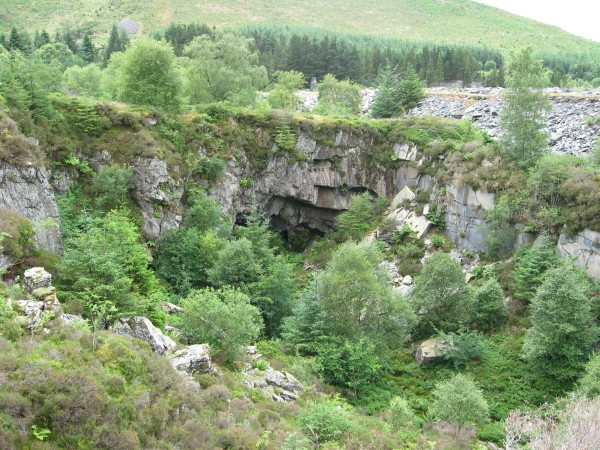
|

|
For July we head up into Mid-Wales, resulting in a steady northward journey since the May picture. (A trip to North-West England for the August picture would perhaps be appropriate, if slightly expensive.) While Wales is predominantly associated with coal, this was in fact only substantially mined in the southern valleys; the ancient kingdoms of Brycheiniog, Deheubarth and Powys remains largely agricultural and Gwynedd (north and west of a line between the Dovey and Dee estuaries) specialised in slate.
Slate varied in profitability based on its quality and how much the mining companies could afford to develop it. The quarries at Penrhyn, Dinorwig and Ffestiniog dug out decent slate in large quanties; they therefore made lots of money and the men who took the mountains from the sheep became lords. The huge gashes caused by the quarries remain harsh and black in the mountainsides and slate tips rise high above Blaenau Ffestiniog, emphasising the often grey weather. But further south, other quarries did exist - albeit rather less successfully.
Between the lake of Talyllyn and the town of Machynlleth lies a rather fine mountain consisting of a slate of slightly less than commercial quality. As the 19th century thundered along it became worth quarrying this area for those who just wanted slate fast for their new factories and houses. The larger basis for this was around the villages at Corris, where slate was mined and quarries for shipment to Machynlleth. On the Talyllyn side of the mountain, the village of Abergynolwyn became the homestead for those working in the smaller Bryneglyws Quarry, from which slate was shipped down two inclines and the Talyllyn Railway to the sea at Tywyn.
If the American Civil War hadn't prompted the cotton millers of Manchester to diversify then there probably wouldn't have been a quarry here at all; in 1911 it was taken over by the local Member of Parliament, Henry Haydn Jones (Lib) to keep his constituents from unemployment. Income remained low, although occasional slate shortages led to spikes in demand which allowed the workforce to receive short-notice bonuses (which were not cleared with the union in advance, resulting in a strike threat; Jones was supposed to be looking after his own, not considering his workforce - that was the union's job). The quarry closed in 1946 when the costs of digging new caverns to extract the slate became too high and mining the posts supporting the roofs of older caverns became too dangerous. Sir Haydn died a few years later and the railway narrowly avoided following him into the history books.
Now the buildings have gone and the caverns are caving in. The picture shows one of them, with the once-underground arches exposed to sunlight and trees finding enough nutrients in the metamorphic rock to scrape a living in this high, remote area.